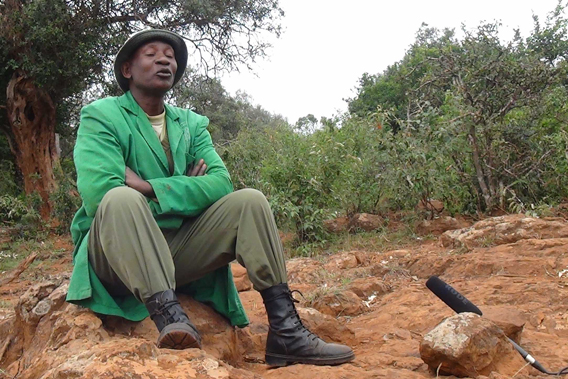
Africa’s Wildest Stories is a new initiative in Kenya to capture personal stories about the relationship of people to nature. Elephant Keeper Mishak Nzimbi (above) has been working at the David Sheldrick center since he was a teenager. It’s a job he would never give up for anything. He is an ordinary man living an extraordinary life: as an elephant nanny, he has raised 80 baby elephants. His story is ‘Life as an Elephant Nanny.’ Photo courtesy of Paula Kahumbu.
Paula Kahumbu, the Executive Director of WildlifeDirect and a 2011 National Geographic Emerging Explorer, is on a mission to reconnect young Africans with the natural world through storytelling. In a new initiative dubbed Africa’s Wildest Stories, Kahumbu and others are recording the wit and wisdom of African elders in Kenya as they share their love of nature and the way in which Africans, for millennia, have co-existed with their environment and its astounding wildlife.
“I believe that we are suffering from a mental and physical disconnection from nature and the importance of the environment especially for sustainable development. We seem to be unaware of what we have,” Kahumbu told mongabay.com in a recent interview about the project which was aided by training in the Landmark Education’s Self-Expression and Leadership Program. “Africa is the only continent remaining on Earth where most megafauna survive including elephants, rhino, antelopes, great apes and big cats. […] The future of wildlife in Africa will depend on younger generations taking good actions to save it.”
A study last year of Africa’s protected areas found that big mammal populations had fallen by 59 percent is 40 years. As precipitous as this decline was the trend is expected to be even greater in unprotected areas. A booming human population, habitat loss, deforestation, big development projects, wildlife trade, and human-wildlife conflict have all taken their toll on wildlife in Africa. Kahumbu adds “intolerance” to these as well.
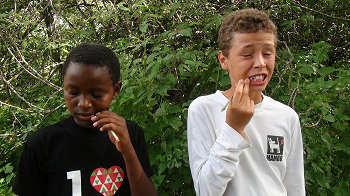 Moniko and Richard are two 11-year-old boys. Richard, a Maasai, explains to Moniko how to make a traditional tootbrush out of a stick. Photo courtesy of Paula Kahumbu. |
“In Kenya people often view wildlife as something that the tourists come to see, and our governments are increasingly treating our protected areas as the next frontier of cheap space to develop,” Kahumbu says. “Despite strong environmental legislation, enforcement is weak, and we are facing unprecedented challenges as African nations race blindly ahead towards ‘development’ while putting the environment in jeopardy.”
Stories span the gamut: one describes the mythical connection between human beings and elephants; another tells a hair-raising tale of an African Bigfoot-like creature; while a third describes the antics of a legendary glutton. Others tell of wild encounters with some of Kenya’s most famous animals including lions, leopards, elephants, and hippos, which are considered the most dangerous animal in the country.
Not only has the initiative recorded wonderful stories, but is also preserving an oral history of the landscape and its people. Kahumbu plans to record stories from all of Kenya’s 45 different tribes. She also hopes to expand the initiative to other African nations.
“The economic argument for wildlife conservation is not working in Africa,” she says. “What I hope to achieve through Africa’s Wildest Stories is a spiritual reconnection to nature and environment. I believe that by reviving and retelling stories about the mutual co-existance between people and the environment, we can inspire current and future generations to protect our heritage, and to acknowledge the role of wildlife in that heritage.”
Kahumbu adds, “You couldn’t put a dollar value on these spiritual values, or on the cost of losing them.”
Listen to the stories on Public Radio Exchange, watch on YouTube, or read about the program on WildlifeDirect.
INTERVIEW WITH PAULA KAHUMBU
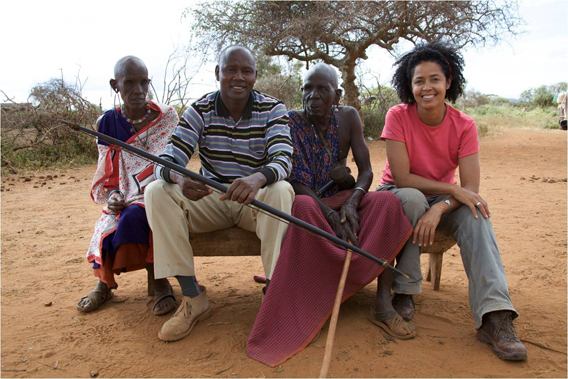
From the story ‘The Glutton.’ Paula (far right) in the field with Moses, Yetuni, and Stefano Cassini filming them.37-year-old Moses Lekina (second from the left) and his father Yetuni Lekina (second to the right) are Maasai pastoralists living in a remote homestead in Kajiado near Mt Kilimanjaro. Moses’ grandfather was legendary man who lived with wildlife and shared his food with lions not people, earning the nickname ‘the glutton.’ Africa’s Wildest Stories honors our elders by listening to and capturing their stories. Most African elders are not literate and cannot write down their own stories. Photo courtesy of Paula Kahumbu.
Mongabay: What is the main premise of ‘Africa’s Wildest Stories’?
Paula Kahumbu: Africa’s Wildest Stories is a digital archive of stories about nature and wildlife told by those who experienced them to inspire younger generations to care about nature and wildlife. When the Serengeti Highway was proposed by the Tanzanian Government, citizens of Tanzania and other African countries were surprisingly silent and it took international outrage to stop the proposal to bisect the famous Serengeti National Park. To many Tanzanians, the Serengeti highway makes development sense as it would bring much needed resources to budding cities in the west of the country. To wildlife and nature lovers, the impacts of this proposed road were unacceptable—it would end the wildebeest migration forever.
I believe that we are suffering from a mental and physical disconnection from nature and the importance of the environment especially for sustainable development. We seem to be unaware of what we have. Africa is the only continent remaining on Earth where most megafauna survive including elephants, rhino, antelopes, great apes and big cats. We are losing many of these species due to land use change, intolerance and illegal trade. The future of wildlife in Africa will depend on younger generations taking good actions to save it. Africa’s Wildest Stories aims to create that connection through sharing lessons and experiences from the past by reviving an age-old oral tradition of story telling.
Mongabay: Why does Africa need these wild stories now?
Paula Kahumbu: Most African countries achieved independence half a century ago and elders in the communities represent individuals born before independence into very different conditions of environment, society, culture and education. With the passing of each elder Africa is losing the wisdom, knowledge and traditional knowledge of how these generations survived natural disasters like droughts, floods, disease and famine, or how they managed natural resources such as wildlife, water, forests and habitats. Though famed for it’s spectacular wildlife heritage, Africa is losing many species including rhinos, the great apes, and the big cats.
The idea came out of a conversation with a Maasai junior elder and wildlife conservationist approached me about his concerns that the wisdom, knowledge and traditions of his people were dying with the loss of the oldest age set, men and women of over 90 years. He warned that this loss of traditional knowledge is already contributing to the challenges that we are making regarding the management of natural resources such as wildlife, water, forests and habitats, and this was leading to intolerance of wildlife and the killing of lions, a species that is already critically endangered in Kenya with fewer than 2,000 remaining.
Mongabay: How do you find the people to tell you these stories?
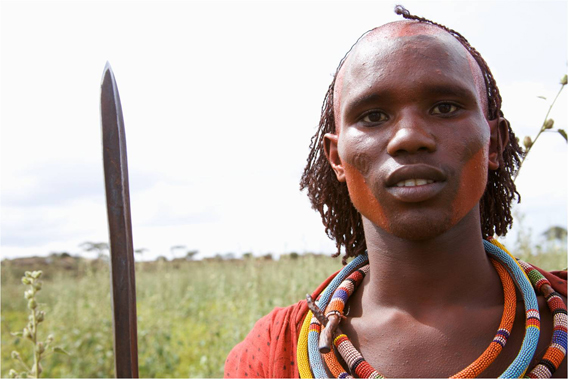
Masaai warrior. Photo courtesy of Paula Kahumbu.
Paula Kahumbu: I believe that everyone has a story to tell. I just ask anyone and everyone if they would like to participate, or if they know someone who wants to participate. So far, nobody has said no. I am targeting certain communities of elders in an attempt to create 50 stories representing Kenya’s 45 tribes and other groups such as Asians and whites.
Mongabay: What wisdom do you hope young Africans glean from these stories?
Paula Kahumbu: I have recorded a Samburu story in northern Kenya about how humans are descended from elephants and that they believe every elephant to be a person. You therefore cannot kill elephants and respect must be shown each time you pass an elephant carcass. To most people around the world snakes are evil and dangerous. They are demonized and persecuted. But one tribe believes that their survival depends on a giant python that protects a forest shrine and keeps the village safe. Amongst the forest living Rabai people it is taboo to harm or kill any snakes. These are the stories that excite me. We can revive, retell, share and keep these stories as a unique way of building a relationship between people and nature.
The economic argument for wildlife conservation is not working in Africa. What I hope to achieve through Africa’s Wildest Stories is a spiritual reconnection to nature and environment. I believe that by reviving and retelling stories about the mutual co-existence between people and the environment, we can inspire current and future generations to protect our heritage, and to acknowledge the role of wildlife in that heritage. Africa’s Wildest Stories also honors our elders as the source of this wisdom, and creates new relatedness between generations, and across tribes, cultures and economic classes. You couldn’t put a dollar value on these spiritual values, or on the cost of losing them.
Mongabay: The project has started in Kenya, do you imagine it expanding to other countries? What are the future plans for Africa’s Wildest Stories?
Paula Kahumbu: Absolutely! Africa’s Wildest Stories is a project conceived and initiated during a Landmark Education training called Self Expression and Leadership Program. We have recorded stories in many Kenyan locations and reflect Kenya’s enormous cultural diversity and our goal is to make the stories accessible through national radio and via our partners, the National Museums of Kenya, at listening stations in selected field museums.
Our next goal is to open make it possible for anyone in Africa to contribute stories to Africa’s Wildest Stories through up a crowd sourcing facility and toolkit. Our goal is to create Africa’s largest archive of stories around nature.
Mongabay: Foreigners often think of East Africa and Kenya as a land of abundant and massive wildlife. Does this still hold true?
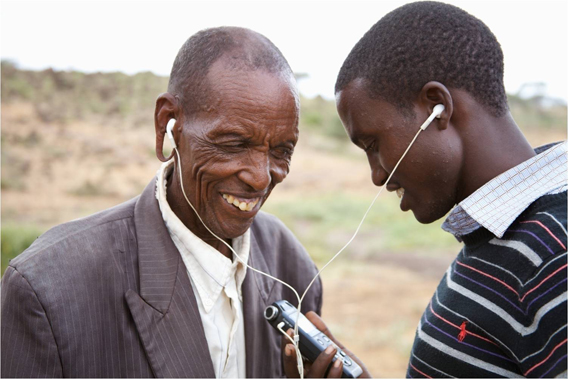
Two generations listen a story recorded for the initiative. Photo courtesy of Paula Kahumbu.
Paula Kahumbu: Yes, it is true that Africa has abundant and massive wildlife, but this is largely restricted to the savannas. Africa’s unique savanna wildlife heritage is migratory, on their own, many Africa’s parks cannot provide adequate space or resources for the needs of this wildlife. We cannot afford to lose migration corridors and dispersal areas. We are in trouble because, despite what is known by science, there is very little political will or economic investment in private and community owned land for conservation.
Many development priorities seem to be unfriendly to wildlife, and perceptions of the general population don’t help. In Kenya people often view wildlife as something that the tourists come to see, and our governments are increasingly treating our protected areas as the next frontier of cheap space to develop. Despite strong environmental legislation, enforcement is weak, and we are facing unprecedented challenges as African nations race blindly ahead towards “development” while putting the environment in jeopardy.
It is going to require private and community land owner participation in conservation to save Africa’s spectacular wildlife heritage.
Mongabay: One of the stories describes a Bigfoot-like beast that eats people. Is this a common tale in East Africa?
Paula Kahumbu: I was taken by surprise when a 90-year-old Maasai elder told me a story about the bigfoot creature. I had heard other legends of ogres and beasts that patrol forests and I always believed that they were told to keep children from getting into danger. I told our interpreter that similar bigfoot stories exist in USA and elsewhere, “Yes but those are stories, this is true” he insisted. In fact two elders claimed that they had actually seen it and this was good enough for the youth to believe it.
Later, I told the story to David Coulson, the Director of the Trust for African Rock Art (TARA) and asked if he had ever heard of similar stories on his travels across Africa. David listened in stunned silence, then narrated his own experiences of “lion men” in Tanzania. He said he read a book written by a Tanzanian policeman about them, and had met a nurse who had witnessed a lion man. It emerged that children, often mentally challenged individuals, were held and trained by witches to be their assassins. The children would be kept in a pit and raised in a feral state for this purpose. The horror inflicted by lion men emerged in Singida when 103 people were killed by lion men in 1946 and 1947. It is possible that such witchcraft practices have led to similar stories emerging across Africa.
Mongabay: Do you have a favorite story?

Annie Olivecrona (left) tells of saving six orphaned chimpanzee from the South Sudan at the height of the civil war. Olivecrona is interviewed by 18-year-old Elleni for the story ‘Saving Chimpanzees from Sudan.’ In all, Olivecrona has raised 28 ‘hairy babies,’ all chimpanzee orphans rescued from war torn countries. Photo courtesy of Paula Kahumbu.
Paula Kahumbu: When I started this project I had preconceived ideas of what kind of stories I would get. I could not have been more wrong and I did not expect to fall in love with Africa over and over again with every story I heard. The generosity of elders, their passion and knowledge has been hugely inspiring.
My favorite story is “the Glutton” told by a 90-year-old man Yetuni Lekina to his 37 year old son Moses. They sat on a rickety bench as the old man narrated tales of his father, a legendary glutton. Yetuni starts by saying “My father says he was extraordinary, he was unlike any other man, he was more like an animal than a human.” Son and father talk and laugh as they recollect the antics of the grandfather. The story is told in Maa and Kiswahili but you don’t need to understand the languages to experience the special connection between this father and son. I was filled with a sense of awe at the wealth of this family in terms of their family.
Mongabay: How can people help?
Paula Kahumbu: There are many ways to help. Listen to the stories and give us your views. Share the stories with your networks, blogs, facebook, twitter and emails so that people can hear them. Africa’s Wildest Stories is also looking for volunteers to help with recording stories, editing or training editors (audio and video), and providing funding and equipment. We are looking for sponsors who care about and want to contribute to nature conservation, protection of African culture and the honor of our elders. The funds will be used to purchase equipment, hire editors, conduct training of story tellers and recorders, create public awareness and get these stories out to millions of Kenyans here and in the diaspora via traditional and social media. We seek to raise $53,000 to cover the costs of one year of operation. Any support would be hugely appreciated. All donations can be made through WildlifeDirect.org.
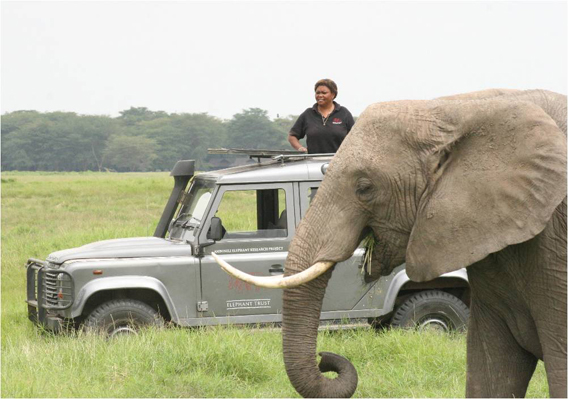
Soila Sayialel is a 47-year-old Maasai community member, and one of the worlds most experienced elephant reserchers, working with Cynthia Moss at the Amboseli Elephant Trust. Her story, ‘the Maasai Warrior Elephant Hunt’ was recorded in a landrover surrounded by over 50 docile elephants. Soila is considered a leader in her community. Photo courtesy of Paula Kahumbu.
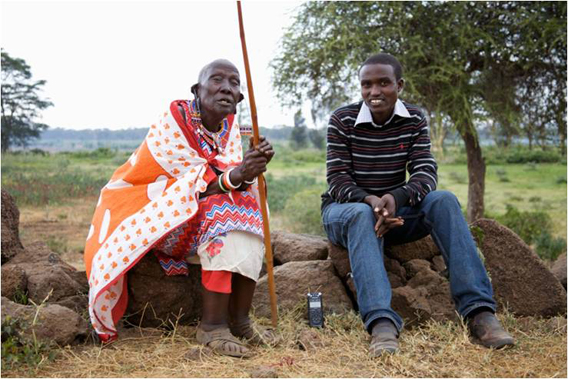
Samuel Nkoe Lesalaon (right) is a young Maasai attending highschool. He assisted the storytelling by conducting interviews with elders including this 80-year-old Maasai woman. Story coming soon. Photo courtesy of Paula Kahumbu.
Related articles
Featured video: conservation challenges in Kenya
(10/12/2011) Paula Kahumbu, National Geographic Emerging Explorer and Executive Director of WildlifeDirect, speaks on the problems facing conservation in Kenya including poverty, human-wildlife conflict, and development.
King of the jungle: lions discovered in rainforests
(08/13/2012) Calling the African lion (Panthera leo) the ‘king of the jungle’ is usually a misnomer, as the species is almost always found in savannah or dry forests, but recent photos by the Germany-based Nature and Biodiversity Conservation Union (NABU) document lions in Ethiopian rainforests. Taken in the Kafa Biosphere Reserve, the photos show a female lion hiding out in thick montane jungle.
Forest cover falls 9% in East Africa in 9 years
(07/31/2012) Forest cover in East Africa has dropped by 9.3 percent from 2001-2009, according to a new paper published in the open-access journal PLoS ONE. Looking at 12 countries in the region, the scientists found that, worryingly, forests were particularly hard hit near protected areas. Usually thought of as a region of vast savannas, such as the Serengeti, East Africa is also home to incredibly biodiverse tropical forests, including coastal forests, rich montane forests, and the eastern portion of the Congo Rainforest.
Poaching in the Serengeti linked to poverty, high legal hunting prices
(07/09/2012) In the effort to protect the Serengeti—arguably Africa’s most famous ecosystem—one of the major problems is the bushmeat trade. Population growth, little available protein, poverty, and a long-standing history of hunting has led many communities to poach wildlife within Serengeti National Park. Interviewing over a thousand community members in the western Serengeti, scientists found that community members are largely aware that wildlife hunting is illegal and that conservation of wild species is important, but hunt animals anyway partly out of necessity.
Ten African nations pledge to transform their economies to take nature into account
(06/11/2012) Last month ten African nations, led by Botswana, pledged to incorporate “natural capital” into their economies. Natural capital, which seeks to measure the economic worth of the services provided by ecosystems and biodiversity—for example pollination, clean water, and carbon—is a nascent, but growing, method to curtail environmental damage and ensure more sustainable development. Dubbed the Gaborone Declaration, the pledge was signed by Botswana, Liberia, Namibia, Mozambique, Rwanda, Gabon, Ghana, Kenya, South Africa, and Tanzania following a two day summit.
Featured video: Honoring Wangari Maathai, who would have been 72 yesterday
(04/02/2012) The indomitable Wangari Maathai would have turned 72 yesterday, April 1st, 2012. Maathai, who was the first African woman and the first environmentalist to win a Nobel Peace Prize (in 2004), passed away last September.
Legal case against Serengeti road moves forward
(03/21/2012) A regional case against the construction of a proposed road through Serengeti National Park has moved to trial after a judge with the East African Court of Justice (EACJ) threw out concerns by Tanzania reports the Daily Nation. The government of Tanzania has proposed a controversial highway that would bifurcate the northern part of the Serengeti National, only to see their plans stalled by a lawsuit filed by the Kenyan-based NGO, Africa Network for Animal Welfare (ANAW), which argues that the road could have massive consequences for the entire Serengeti ecosystem, a view shared by many scientists.
Africa Wildlife Foundation faces lawsuit from indigenous community in Kenya
(03/12/2012) Africa Wildlife Foundation (AWF), the conservation nonprofit based in Washington, DC, is facing a lawsuit by Kenya’s Samburu tribe over alleged unlawful evictions. The hearing, originally scheduled for January 23, has now been postponed to later this month. The dispute is over an area of land in Laikipia District in Kenya, one of Africa’s most wildlife rich areas. Until recently, it was also the homeland of some 2,000 semi nomadic members of the Samburu tribe. At least according to the Samburu.
International Bird Area in Kenya saved from conversion into biofuel crop
(02/29/2012) A campaign by NGO Nature Kenya has saved the Dakatcha Woodland Important Bird Area (IBA) from destruction for planting biofuel crops, reports BirdLife International. Located near Kenya’s eastern coastline, the forest is home to two IUCN Red List Endangered species, Clarke’s weaver (Ploceus golandi) and sokoke pipit (Anthus sokokensis), both of which are imperiled by habitat loss. The plan to covert 10,000 hectares of the forest in jatropha, used for biofuels, was recently rejected by Kenya’s National Environment Management Authority (NEMA).
Eco-toilets help save hippos and birds in Kenya
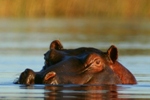
(01/04/2012) It may appear unintuitive that special toilets could benefit hippos and other wetland species, but the Center for Rural Empowerment and the Environment (CREE) has proven the unique benefits of new toilets in the Dunga Wetlands on Lake Victoria’s Kenyan side. By building ecologically-sanitary (eco-san) toilets, CREE has managed to alleviate some of the conflict that has cropped up between hippos and humans for space.
